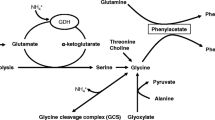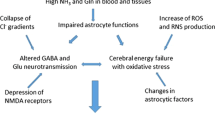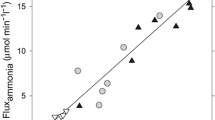Abstract
There appears to be a consensus that hepatic encephalopathy (HE) is a metabolic encephalopathy with a multifactorial pathogenesis. One of the factors considered to be important in the pathogenesis of HE is ammonia. However, the mechanisms by which ammonia contributes to the manifestations of HE remain poorly defined. Ammonia could be more definitively implicated in the pathogenesis of HE if its effects can be shown to lead to an enhancement of inhibitory neurotransmission. In this context the effects of ammonia on the GABA (γ-aminobutyric acid) neurotransmitter system may be relevant. Ammonia, at the modestly increased concentrations that commonly occur in precoma HE (0.15 mM–0.75 mM), has been shown to increase GABA-induced chloride current in cultured neurons, probably by modifying the affinity of the GABA(A) receptor for GABA. Comparable ammonia concentrations also enhanced synergistically the binding of a GABA agonist and a benzodiazepine (BZ) agonist to the GABA(A) receptor complex, phenomena which would enhance the neuroinhibitory effects of these ligands. Also, GABA increased the potency of ammonia-induced enhancement of the binding of a BZ agonist to the GABA(A) receptor complex, and brain levels of BZ agonists are elevated in liver failure. In addition, ammonia has been shown to inhibit astrocytic uptake of GABA by 30%–50%, an effect which would increase the synaptic availability of GABA at GABA(A) receptors. Furthermore, increased ammonia concentrations upregulate the peripheral-type benzodiazepine receptor in the outer membrane of astroglial mitochondria, thereby enhancing astrocytic mitochondrial synthesis and release of neurosteroids. Some neurosteroids, for example tetrahydroprogesterone (THP) and tetrahydrodeoxycorticosterone (THDOC), are potent agonists of the GABA(A) receptor complex, on which there are specific binding sites for neurosteroids, that are distinct from those for BZs and barbiturates. Tetrahydroprogesterone and tetrahydrodeoxycorticosterone levels were found to be increased in a mouse model of acute liver failure, and, when THP or THDOC was injected into normal mice, sedation and Alzheimer type II astrocytic changes in the cortex, striatum, and hypothalmus were induced. Each of these direct or indirect effects of ammonia on the GABA neurotransmitter system has the potential of increasing inhibitory neurotransmission, and, hence, contributing to the manifestations of HE.
Similar content being viewed by others
REFERENCES
Akwa, Y., Sananes, N., Gouezou, M., Robe1, P., Baulieu, E.E., and Le Gascogne, C. (1993). Astrocytes and neurosteroids: Metabolism of pregnenolone and dehydro-epiandrosterone. Regulation by cell density. J. Cell Biol. 12:135-143.
Anholt, R.R.H., Pedersen, P.L., DeSouza, E.B., and Snyder, S.H. (1986). The peripheral-type benzodiazepine receptor: Localization to the mitochondrial outer membrane. J. Biol. Chem. 261:576-583.
Basile, A.S. (1991). The contribution of endogenous benzodiazepine receptor ligands to the pathogenesis of hepatic encephalopathy. Synapse 7:141-150.
Basile, A.S., Jones, and E.A. (1997). Ammonia and GABA-ergic neurotransmission: Interrelated factors in the pathogenesis of hepatic encephalopathy. Hepatology 25:1303-1305.
Basile, A.S., and Skolnick, P. (1986). Subcellular localization of “peripheral-type” binding sites for benzodiazepines in rat brain. J. Neurochem. 46:305-308.
Basile, A.S., Pannell, L., Jaouni, T., Gamma1, S.H., Fales, H., Jones, E.A., et al. (1990). Brain concentrations of benzodiazepines are elevated in an animal model of hepatic encephalopathy. Proc. Natl. Acad. Sci. U.S.A. 87:5263-5267.
Basile, A.S., Hughes, R.D., Harrison, P.M., Murata, Y., Pannell, L., Jones, E.A., et al. (1991). Elevated brain concentrations of 1,4-benzodiazepines in fulminant hepatic failure. N. Engl. J. Med. 325:473-478.
Bender, A.S., and Norenberg, M.D. (2000). Effect of ammonia on GABA uptake and release in cultures astrocytes. Neurochem. Int. 36:389-395.
Butterworth, R.F. (1996). The neurobiology of hepatic encephalopathy. Semin. Liver Dis. 16:235-244.
Butterworth, R.F. (2000). The astrocytic (“peripheral-type”) benzodiazepine receptor: Role in the pathogenesis of portal-systemic encephalopathy. Neurochem. Int. 36:41l-416.
Ha, J.-H., and Basile, A.S. (1996). Modulation of ligand binding to components of the GABA(A) receptor complex by ammonia: Implications for the pathogenesis of hyperammonemic syndromes. Brain Res. 720:35-44.
ltzhak, Y., and Norenberg, M.D. (1994a). Ammonia-induced upregulation of peripheral-type benzodiazepine receptors in cultured astrocytes labeled with [3H]PK 11195. Neurosci. Lett. 177:35-38.
ltzhak, Y., and Norenberg, M.D. (1994b). Attenuation of ammonia toxicity in mice by PK 11195 and pregnenolone sulfate. Neurosci. Lett. 182:251-254.
ltzhak,Y., Baker, L., and Norenberg, M.D. (1993). Characterization of the peripheral-type benzodiazepine receptor in cultured astrocytes: Evidence for multiplicity. Glia 9:211-218.
ltzhak, Y., Roig-Cantisano, A., Dombro, R.S., and Norenberg, M.D. (1995). Acute liver failure and hyperammonaemia increase peripheral-type benzodiazepine receptor binding and pregnenolone synthesis in mouse brain. Brain Res. 705:345-348.
Jones, E.A., Basile, and A.S. (1998). Does ammonia contribute to increased GABA-ergic neurotransmission in liver failure? Metab. Brain. Dis. 13:351-260.
Jones, E.A. (2000). Pathogenesis of hepatic encephalopathy. Clin. Liver Dis. 4:467-485.
Jones, E.A., and Weissenborn K. (1997). Neurology and the liver. J. Neurol. Neurosurg. Psychiatry 63:279-293.
Kadota,Y., lnoue, K., Tokunaga, R., and Taketani, S. (1996). Induction of peripheral-type benzodiazepine receptors in mouse brain following thioacetamide-induced acute liver failure. Life Sci. 58:953-959.
Krueger, K.E., and Papadopoulos, V. (1992). Mitochondrial benzodiazepine receptors and the regulation of steroid biosynthesis. Ann. Rev. Pharmacol. Toxicol. 32:21l-237.
Lambert, J.J., Belelli, D., Hill-Venning, C., and Peters, J.A. (1995). Neurosteroids andGABA(A) receptor function. Trends Pharmacol. Sci. 16:295-303.
Lavoie, J., Pomier, L.G., and Butterworth, R.F. (1990). Increased densities of peripheral-type benzodiazepine receptors in brain autopsy samples from cirrhotic patients with hepatic encephalopathy. Hepatology 11:874-878.
Majewska, M.D., Harrison, N.L., Schwartz, R.D., Barker, J.L., and Paul, S.M. (1986). Steroid hormone metabolites are barbiturate-like modulators of the GABA receptor. Science 232:1004-l007.
Majewska, M.D., and Schwartz, R.D. (1987). Pregnenolone-sulfate: An endogenous antagonist of the gammaaminobutyric acid receptor complex in brain? Brain Res. 404:355-360.
Mullen, K.D., and Jones, E.A. (1996). Natural benzodiazepines and hepatic encephalopathy. Semin. Liver Dis. 16:255-264.
Norenberg, M.D., Mozes, L.W., and Papendick, R.E. (1985). Effect of ammonia on glutamate, GABA, and rubidium uptake by astrocytes. Ann. Neurol. 18:149.
Norenberg, M.D., ltzhak, Y., and Bender, A.S. (1997). The peripheral benzodiazepine receptor and neurosteroids in hepatic encephalopathy. Adv. Exp. Med. Biol. 420:95-111.
Olasmaa, M., Rothstein, J.D., Guidotti, A., Weber, R.J., Paul, S.M., Spector, S., et al. (1990). Endogenous benzodiazepine receptor ligands in human and animal hepatic encephalopathy. J. Neurochem. 55:2015-2033.
Papadopoulos V. (1990). Peripheral-type benzodiazepine/diazepam binding inhibitor receptor: Biological role in steroidogenic cell funtion. Endoscine Rev. 14:222-240.
Papadopoulos, V. (1993). Peripheral-type benzodiazepine/diazepam binding inhibitor receptor: Biological role in steroidogenic cell function. Endocr. Rev. 14:222-240.
Takahashi, K., Kameda, H., Kataoka, M., Sanjou, K., Harata, N., and Akaike, N. (1993). Ammonia potentiates GABA(A) response in dissociated rat cortical neurons. Neurosci. Lett. 151:51-54.
Turner, M.M., Ransom, R.W., Yang, J.S., and Olsen, R.W. (1989). Steroid anaesthetics and naturally occurring analogs modulate the gamma-aminobutyric acid receptor complex at a site distinct from barbiturates. J. Pharmacol. Exp. Ther. 248:960-966.
Willow, M., and Johnson, G.A.R. (1981). Dual action of pentobarbitone on GABA binding: Role of binding site integrity. J. Neurochem. 37:1291-1294.
Rights and permissions
About this article
Cite this article
Jones, E.A. Ammonia, the GABA Neurotransmitter System, and Hepatic Encephalopathy. Metab Brain Dis 17, 275–281 (2002). https://doi.org/10.1023/A:1021949616422
Issue Date:
DOI: https://doi.org/10.1023/A:1021949616422




